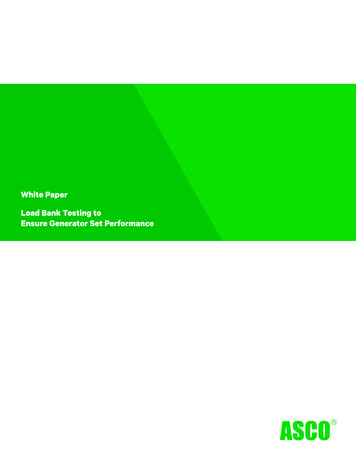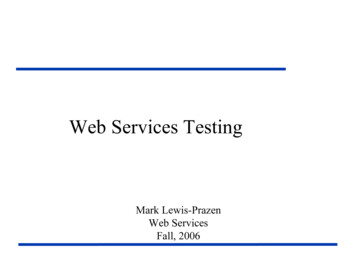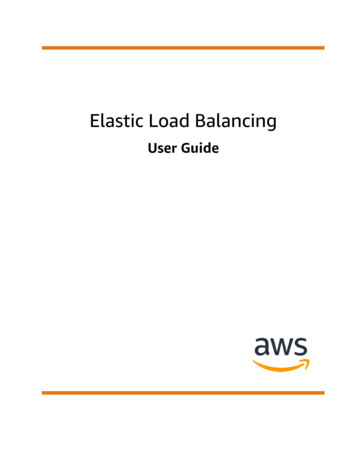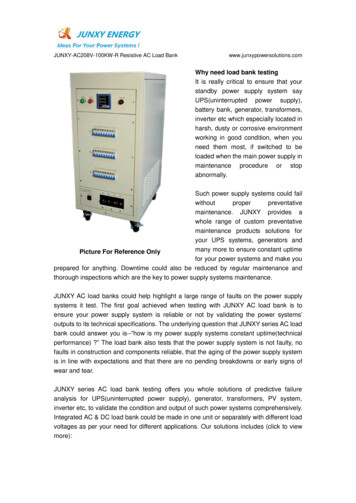
Transcription
Load Testing AnalysisServicesGerhard Brückl
About MeGerhard Brückl Working with Microsoft BI since 2006 Mainly focused on Analytics and Reporting Analysis Services / Reporting ServicesPower BI / O365MDX / DAXSAP HANA Blog: w.pmone.com
Agenda What is Load Testing? Why Load Testing? Setting up a Load Test Load Testing Analysis Services Parameters Tools
What is Load Testing? According to Wikipedia:“Load testing is the process of putting demand on a system ordevice and measuring its response. Load testing is performed todetermine a system’s behavior under both normal andanticipated peak load conditions. It helps to identify themaximum operating capacity of an application as well as anybottlenecks and determine which element is causingdegradation.”
Unit Testingvs.Load Testing
Why Load Testing?Several Reasons: Reduce Risk Reduce Cost Identify Bottlenecks Performance Tuning Prove Scalability
Why Load Testing?Common questions: How many users can my architecture support? What is the expected average response time? When/Why does my performance decrease? What is the best hardware setup? Is an upgrade worth the investment?
Setting up a Load Test
Setting up a Load Test Define your Goals! Define the Test Set Choose your Tools Run the Load Test
Define your Goals! Hypothesis I need an average response time of X seconds I need to support X concurrent users Must be measureable and realistic! Investigation Why is my performance decreasing with X users? Why is my cube so slow?
Define the Test Set Capture from Prod System Extract from Reports Free-Form Queries Parameterize your Test Set!
Parameterizing the Test Set Page-Filters Varying Rows and Columns Varying Measures
Choose your Tools SQL Server Profiler ASCMD (with Stress Testing Scripts) AS Performance Workbench Visual Studio Self Programmed SSIS
Criterias for Choosing your Tools Serial vs. Parallel Execution Performance Measurements Easy Parametrization Multiple Users / Security Multiple Clients / Locations Result Store / Analysis
Running the Load lineLoad TestRecord andAnalyzeResultsRunLoad Test
Monitoring and Benchmarking Performance Min/Max/Avg Test Duration Number of Tests Executed Number of Users Hardware Utilization CPUMemoryI/O(Network)
Analyzing the Results
Expected results(1)(2)(3)Concurrent UsersAvg. queryresponse time(1) Constant test duration(2) Until saturation point is reached(3) Linear increase of test duration together with concurrent users
The Myth of “Concurrent Users”Defining Concurrency?“How many users can run a queryat the same time““How many queries can be answered/ How many users can be satisfiedwithin a given time period“
The Myth of “Concurrent Users”Infinite Number ofConcurrent Users?!?Available ResourcesUser nUser 6User 5User 4User 3User 2User 1Execution time
Available ResourcesThe Myth of “Concurrent Users”User 4User 3User 2User 1Execution time
Available ResourcesThe Myth of “Concurrent Users”User 4User 3User 2User 1Execution time
Available ResourcesThe Myth of “Concurrent Users”User 4User 3User 2User 1Execution time
Finding the Bottleneck CPU 90% ? Memory Available Server Memory SSAS Memory Usage vs. Memory Limits IO Read Bytes/Sec Disk Queue Lengths SSAS Threads
Changing the Parameters
Changing Parameters Software OS Settings SSAS Configuration (Cube Design/MDX Script) Hardware / Architecture CPU Memory I/O
Common Misconfigurations Virus Scanner Windows Power Settings Slow SAN Indexed/Encrypted Data Directory SQL Server RDBMS on same Machine Bad Cube Design/MDX Script
Visual Studio Load Testing
AS Load Sim AS Load Simulation integration into VS Test Suite Framework can/has to be extended C# code For Baseline tests Fixed set of queries Random queries Variable number of users
VS Test Suite – Overview
VS Test Suite – Overview Test Controller Controls several Test Agents Logs results into Database Number of Tests Average Test duration Test Agent Runs queries against website / database to test (SSAS, SQL, ) Logs results into Database Local PerfMon counters Tests per Agent
VS Test Suite –Test-Controllers Every Test Controller has to be configured Load test result store: relational database to store test results Agents: manage Agents that the controller “owns”
VS Test Suite – Test-Controllers Create Load Test Store SQL Scripts Create DB: LoadTestResultsRepository.sql Upgrade DB: UpgradeLoadTestResultsRepository.sql Scripts can be found atC:\Program Files (x86)\Microsoft Visual Studio 10.0\Common7\IDE
VS Test Suite – Testconfiguration
VS Test Suite – Testconfiguration Constant Load Always same amount of concurrent Users Step Load Increasing number of Userswith each Step
VS Test Suite – Testconfiguration Test Mix Add the ASLoadSim Projectas a Test Mix
VS Test Suite – Testconfiguration Network Mix: Originally used to run browser-tests In our case always set itto LAN and 100%
VS Test Suite – Testconfiguration Counter Sets Can use predefined sets Can create custom sets
VS Test Suite – Testconfiguration Run Settings Limit number of testruns By duration By numberof iterations Sampling rate Frequency in which Performancecounters are logged
VS Test Suite – Testconfiguration Counter Sets Collection of Performance Counters Same Counters that are also available via PerfMon
VS Test Suite – Testconfiguration Assigning Counter Sets -Counter Sets can be assigned to any participating ComputerControllerAgentTest-Server- SSAS- SQL-
VS Test Suite – Running the Test
VS Test Suite – Analyzing the Results Results are stored in the Load Test Store( SQL Database) Can be accessed via Visual Studio
Live-Demo
Summary Be sure what you actually want to achieve with your Load Test Use appropriate Tools Know your System Hardware – physical Limitations Cube/Model – design Limitations Make tests as real as possible – Security!
What is Load Testing? According to Wikipedia: "Load testing is the process of putting demand on a system or device and measuring its response. Load testing is performed to determine a system's behavior under both normal and anticipated peak load conditions. It helps to identify the maximum operating capacity of an application as well as any









